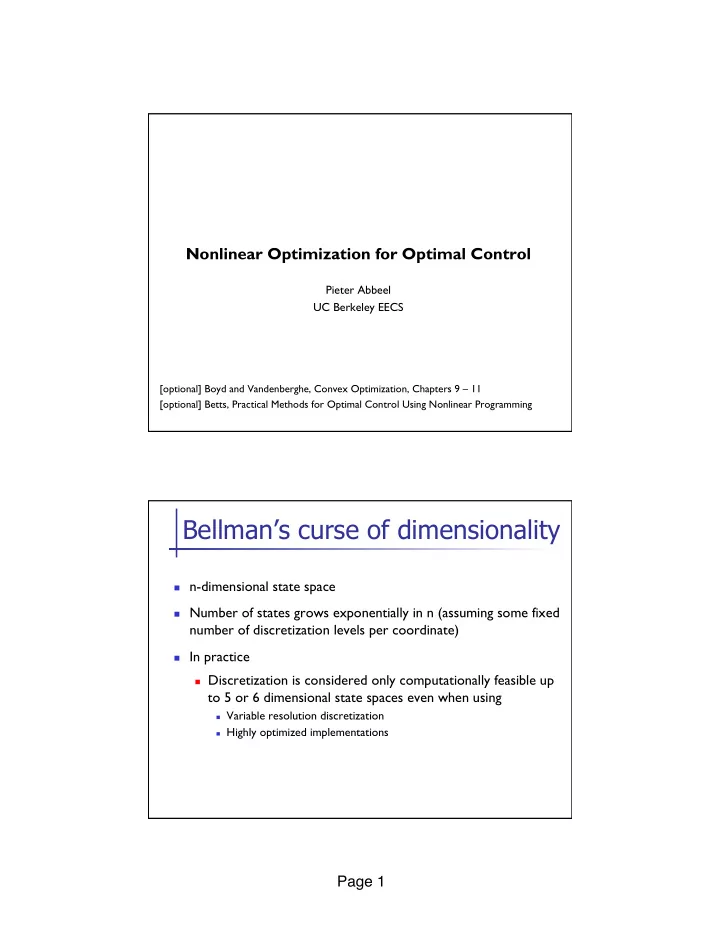

Nonlinear Optimization for Optimal Control Pieter Abbeel UC Berkeley EECS [optional] Boyd and Vandenberghe, Convex Optimization, Chapters 9 – 11 [optional] Betts, Practical Methods for Optimal Control Using Nonlinear Programming Bellman’s curse of dimensionality n n-dimensional state space n Number of states grows exponentially in n (assuming some fixed number of discretization levels per coordinate) n In practice n Discretization is considered only computationally feasible up to 5 or 6 dimensional state spaces even when using n Variable resolution discretization n Highly optimized implementations Page 1 �
This Lecture: Nonlinear Optimization for Optimal Control Goal: find a sequence of control inputs (and corresponding sequence n of states) that solves: Generally hard to do. We will cover methods that allow to find a n local minimum of this optimization problem. Note: iteratively applying LQR is one way to solve this problem if n there were no constraints on the control inputs and state Outline n Unconstrained minimization n Gradient Descent n Newton’s Method n Equality constrained minimization n Inequality and equality constrained minimization Page 2 �
Unconstrained Minimization If x* satisfies: n then x* is a local minimum of f. In simple cases we can directly solve the system of n equations given by (2) to find n candidate local minima, and then verify (3) for these candidates. In general however, solving (2) is a difficult problem. Going forward we will n consider this more general setting and cover numerical solution methods for (1). Steepest Descent n Idea: n Start somewhere n Repeat: Take a small step in the steepest descent direction Local Figure source: Mathworks Page 3 �
Steep Descent n Another example, visualized with contours: Figure source: yihui.name Steepest Descent Algorithm 1. Initialize x 2. Repeat 1. Determine the steepest descent direction ¢ x 2. Line search. Choose a step size t > 0. 3. Update. x := x + t ¢ x. 3. Until stopping criterion is satisfied Page 4 �
What is the Steepest Descent Direction? Stepsize Selection: Exact Line Search n Used when the cost of solving the minimization problem with one variable is low compared to the cost of computing the search direction itself. Page 5 �
Stepsize Selection: Backtracking Line Search n Inexact: step length is chose to approximately minimize f along the ray {x + t ¢ x | t ¸ 0} Stepsize Selection: Backtracking Line Search Figure source: Boyd and Vandenberghe Page 6 �
Gradient Descent Method Figure source: Boyd and Vandenberghe Gradient Descent: Example 1 Figure source: Boyd and Vandenberghe Page 7 �
Gradient Descent: Example 2 Figure source: Boyd and Vandenberghe Gradient Descent: Example 3 Figure source: Boyd and Vandenberghe Page 8 �
Gradient Descent Convergence Condition number = 10 Condition number = 1 For quadratic function, convergence speed depends on ratio of highest n second derivative over lowest second derivative (“condition number”) In high dimensions, almost guaranteed to have a high (=bad) condition n number Rescaling coordinates (as could happen by simply expressing quantities in n different measurement units) results in a different condition number Outline n Unconstrained minimization n Gradient Descent n Newton’s Method n Equality constrained minimization n Inequality and equality constrained minimization Page 9 �
Newton’s Method n 2 nd order Taylor Approximation rather than 1 st order: assuming , the minimum of the 2 nd order approximation is achieved at: Figure source: Boyd and Vandenberghe Newton’s Method Figure source: Boyd and Vandenberghe Page 10 �
Affine Invariance n Consider the coordinate transformation y = A x n If running Newton’s method starting from x (0) on f(x) results in x (0) , x (1) , x (2) , … n Then running Newton’s method starting from y (0) = A x (0) on g (y) = f(A -1 y), will result in the sequence y (0) = A x (0) , y (1) = A x (1) , y (2) = A x (2) , … n Exercise: try to prove this. Newton’s method when we don’t have n Issue: now ¢ x nt does not lead to the local minimum of the quadratic approximation --- it simply leads to the point where the gradient of the quadratic approximation is zero, this could be a maximum or a saddle point n Three possible fixes, let be the eigenvalue decomposition. n Fix 1: n Fix 2: n Fix 3: In my experience Fix 2 works best. Page 11 �
Example 1 gradient descent with Newton’s method with backtracking line search Figure source: Boyd and Vandenberghe Example 2 gradient descent Newton’s method Figure source: Boyd and Vandenberghe Page 12 �
Larger Version of Example 2 Gradient Descent: Example 3 Figure source: Boyd and Vandenberghe Page 13 �
Example 3 Gradient descent n Newton’s method (converges in one step if f convex quadratic) n Quasi-Newton Methods n Quasi-Newton methods use an approximation of the Hessian n Example 1: Only compute diagonal entries of Hessian, set others equal to zero. Note this also simplfies computations done with the Hessian. n Example 2: natural gradient --- see next slide Page 14 �
Natural Gradient n Consider a standard maximum likelihood problem: n Gradient: n Hessian: n Natural gradient only keeps the 2 nd term 1: faster to compute (only gradients needed); 2: guaranteed to be negative definite; 3: found to be superior in some experiments Outline n Unconstrained minimization n Gradient Descent n Newton’s Method n Equality constrained minimization n Inequality and equality constrained minimization Page 15 �
Outline n Unconstrained minimization n Equality constrained minimization n Inequality and equality constrained minimization Page 16 �
Recommend
More recommend